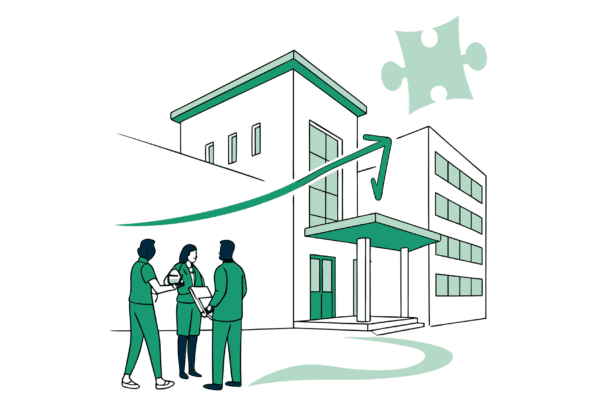Selling your San Antonio Telehealth & Digital Therapy practice presents a significant opportunity in today’s rapidly expanding market. The demand for virtual care is at an all-time high, creating a favorable environment for owners considering an exit. However, capitalizing on this trend requires informed navigation of Texas-specific regulations, buyer expectations, and the valuation process. This guide provides key insights to help you understand the landscape and prepare for a successful transition.
Market Overview
The timing for selling a telehealth practice has rarely been better. Nationally, the telehealth market is on a trajectory of substantial growth, with some projections reaching over $400 billion by 2033. This national trend is strongly reflected here in Texas. Post-pandemic, San Antonio has experienced a significant and sustained increase in demand for virtual health services.
This creates a seller’s market where sophisticated buyers, from private equity groups to larger health systems, are actively looking for established and scalable telehealth platforms. For a practice owner in San Antonio, this means you are operating in a location with proven local demand, backed by a powerful national growth narrative. This combination increases the potential for a premium valuation.
Key Considerations for San Antonio Sellers
While market tailwinds are strong, a successful sale depends on the details of your practice. Buyers will look closely at several key areas specific to the telehealth model and Texas law.
Navigating Texas Regulations
Your practice must be in full compliance with Texas Medical Board rules for telehealth. This includes maintaining proper physician-patient relationships, adhering to the standard of care, and ensuring all providers are appropriately licensed in Texas. Documentation of patient consent and secure medical records are not just best practices. They are requirements that buyers will verify during due diligence.
Showcasing Your Technology and Patient Base
Your technology platform is a core asset. Be prepared to demonstrate its security, ease of use for patients and providers, and any unique features. Beyond the tech, the story of your patient base is critical. Data on patient numbers, retention rates, and demographics within the San Antonio area provides concrete evidence of your practice’s market position and stability.
Understanding Ownership Rules
A critical legal point in Texas is the general prohibition on the corporate practice of medicine. This restricts non-physicians from owning a medical practice or employing physicians. This rule has significant implications for who can buy your practice and how the deal must be structured. Navigating this requires careful planning to attract the widest possible pool of qualified buyers.
Market Activity
While specific private sales in San Antonio are not always public, the national M&A landscape shows intense interest in the telehealth sector. We see major transactions that confirm the high value placed on well-run virtual care platforms. For instance, the acquisition of Access Physicians by SOC Telemed for $194 million highlights the scale of investment flowing into this space.
This activity sends a clear signal. Buyers are willing to pay a premium for telehealth practices with efficient operations, a strong provider network, and a loyal patient base. They see the profitability, with virtual visits often yielding strong returns, and the immense potential for scalability. Your San Antonio practice is positioned to benefit directly from this national M&A momentum.
The Sale Process at a Glance
Selling a practice is a structured process that goes far beyond just finding a buyer. Understanding the typical stages can help you prepare. Many owners think about selling 2-3 years before they act. That is the perfect time to start preparing, as buyers pay for proven performance, not just potential. Here are the key phases:
- Preparation and Valuation. This is the foundation. It involves getting your financial and legal documents in order and, most importantly, determining what your practice is truly worth through a professional valuation.
- Confidential Marketing. Your practice is presented to a curated list of potential buyers without revealing your identity. This protects your relationships with staff and patients.
- Negotiating Offers. You will likely receive interest from multiple parties. An advisor helps you compare offers, which often include different structures, and negotiate terms that best meet your goals.
- Navigating Due Diligence. This is a critical hurdle. The buyer will conduct an in-depth review of your finances, operations, and legal compliance. Being thoroughly prepared here prevents surprises that could derail the sale.
- Closing and Transition. Once due diligence is complete, final legal documents are signed, and the practice officially changes hands. A smooth transition plan is key to protecting your legacy and ensuring continuity of care.
How Your Practice is Valued
One of the first questions any owner asks is, “What is my practice worth?” The answer is more complex than a simple multiple of your annual revenue. Sophisticated buyers value your practice based on its profitability and future potential, which is captured by a key metric: Adjusted EBITDA.
EBITDA stands for Earnings Before Interest, Taxes, Depreciation, and Amortization. It is a measure of cash flow. We then “adjust” it by adding back personal expenses run through the business (like a car lease) and normalizing any owner salary that is above or below market rate. This gives a true picture of the practice’s profitability. This Adjusted EBITDA figure is then multiplied by a number (the multiple) that reflects your practice’s specific strengths, such as your technology, scalability, and patient diversity. A practice that can run without its founding owner will always command a higher multiple.
Planning for Life After the Sale
The day you close the sale is not the end of the story. The structure of your deal has major implications for your after-tax proceeds, your future role, and your financial legacy. For many owners, the fear of losing control is a major concern. However, modern deals can be structured to keep you involved if you wish.
It is important to think about these options early in the process. Two common structures are earnouts and equity rollovers. They serve different purposes but can help align your goals with the buyer’s.
| Feature | Earnout Payments | Equity Rollover |
|---|---|---|
| Purpose | To reward you for future performance. | To let you maintain ownership and future upside. |
| How It Works | You receive additional cash payments if the practice hits pre-agreed revenue or profit targets after the sale. | You “roll over” a portion of your sale proceeds into stock in the new, combined company. |
| Best For | Owners who are confident in short-term growth and want to maximize the total sale price. | Owners who believe in the buyer’s vision and want a potential “second bite of the apple” when the larger company is sold again. |
Planning for these post-sale realities is just as important as the sale itself. The right strategy ensures the transition protects your staff, your legacy, and your financial future.
Frequently Asked Questions
What makes San Antonio a good market for selling a telehealth practice?
San Antonio benefits from a significant and sustained increase in demand for virtual health services post-pandemic. This creates a seller’s market where buyers, including private equity groups and health systems, are actively seeking established telehealth practices, increasing the potential for a premium valuation.
What Texas-specific regulations should sellers be aware of when selling a telehealth practice?
Sellers must comply with Texas Medical Board rules, including maintaining physician-patient relationships, adhering to the standard of care, ensuring all providers are licensed in Texas, documenting patient consent, and securing medical records. Buyers will verify these during due diligence.
How is a telehealth practice valued in San Antonio?
Valuation is based on Adjusted EBITDA (Earnings Before Interest, Taxes, Depreciation, and Amortization), which reflects cash flow adjusted for personal expenses and normalized owner salary. This figure is multiplied by a practice-specific multiple considering technology, scalability, and patient diversity.
What are common deal structures after selling a telehealth practice in San Antonio?
Two common structures are earnouts and equity rollovers. Earnouts provide additional payments if the practice meets future revenue/profit targets, ideal for owners confident in growth. Equity rollovers involve reinvesting sale proceeds into the buyer’s company, allowing owners to maintain ownership and potentially benefit from future sales.
What steps should an owner take to prepare for selling their telehealth practice?
Preparation involves organizing financial and legal documents and obtaining a professional valuation. Next is confidential marketing to potential buyers, negotiating offers, navigating due diligence, and finally closing with a smooth transition plan to protect legacy and patient care continuity.



